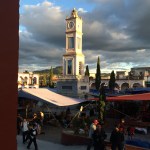-

-
No respectable American is without his watch.
-

-
Aztec calendars recorded time as a cycle.
-

-
Towns used to have a tower to tell local time.
Tlaxiaco, Oaxaca, Mexico
-

-
Calendars keep track of events in linear fashion.
New Year’s 2015
I don’t know how many times I’ve heard Americans say things like: ‘You can’t depend on Mexicans, they’re always late.’ Or: ‘Why can’t they show up when they’re supposed to?’ Or: ‘Well, you know, they’re on Mexican time.’
The phrase ‘Mexican time’ is sometimes a sympathetic phrase and at other times it’s an epithet. It depends on who says it, to whom it’s said, and why. Why are American travelers so annoyed when services or appointments don’t happen promptly on their timetable? It’s culture.
When my friends Juan and María invite me to a family dinner in Minnesota, they say: ‘Come any time after 4:00.’ Just to be sure, I ask if they mean 4:00 as in ‘Mexican time’ or in American or ‘gringo time’. We laugh at this because we both understand the cultural differences in ideas about time in Mexico and the United States.
I tell them I’ll arrive at 4:00 p.m. ‘Mexican time’ because I’ve learned an early arrival isn’t a virtue. I don’t want to be the first one at the party. Besides, I know the party really starts much later. Nonetheless, my grasp of ‘Mexican time’ is still faulty, and when I arrive at 5:00 or 5:30, I’m still among the first to show up. If I show up that late for an American invitation, the host will be upset; 4:00 means 4:00.
Time, as an idea and as a reality, differs across American and Mexican cultures. What is ‘time’? Astrophysicists are still debating whether time really exists. Without going into the theories of time, it is enough to say the operational ideas of time in Mexico and the United States reflect their respective histories, cultural origins, and daily realities. The idea of time influences social conventions, expectations, and customs. American cultural ideas about time are embedded in everyday speech. The phrase: ‘Time is money’ epitomizes the Yankee notion of time.
A clock had little relevance to daily life when I was growing up on our farm. Time played out as a sequence of chores and tasks without a definite beginning or end. Each day, we milked cows at daybreak, raked hay after the dew dried, ate dinner at midday (somewhere between 11 a.m. and 1 p.m.), and then built fences, harvested corn, or plowed the stubble until sunset. That was about as definite as our time could be (except for church at 10:30 a.m. on Sunday morning). We lived on ‘rural time’ until the mid-1960s, as did all but the most urbanized Americans.
‘Mexican time’ and ‘rural time’ share a lot in common because Mexico was a very rural nation until very recently. ‘Mexican time’ and American ‘rural time’ move according to interlocking cycles: The daily one of milking and tending animals; the annual one of planting, cultivating, and harvesting. Rural people don’t ‘punch the clock’. Hours matter less than the completion of one task before starting another. And if a task takes too long, it often bumps a chore of lesser importance. ‘Mexican time’ and American ‘rural time’ contain an inherent latitude or courtesy, understood by all, to accommodate the unforeseen events that otherwise cause someone to arrive ‘late.’
But there are some exceptions. In Puebla, when my friend Maribel invited me to the surprise party for her eighteen year-old niece, she sent me the address with explicit instructions to arrive at 2:30 – ‘al punto’. ‘Al punto’ means ‘on the dot’ (punto) at 2:30 p.m. sharp so everyone would be ready to surprise the neice when she arrived.
When someone agrees to meet you ‘al punto’, treat it as a gift because it is. It means your friend will put the promise to meet you ahead of anything else that might intrude. ‘Al punto’ means giving control of your time to someone else. I’ve had very few social meetings ‘al punto’ in Mexico. Ordinarily, we meet at an approximate time; neither of us feels abashed to be fifteen minutes ‘late’ nor do we feel a need to arrive on the dot. Apologies aren’t necessary or expected.
American rural (and Mexican) time is as idiosyncratic and as regular as my pulse. ‘Mexican time’ is more subjective and fluid than ‘American time’. My Mexican friends regard their time as an integral part of themselves, it’s a form of personal property. I have time, it is mine, and it goes with me everywhere. You have time, too; it’s your personal possession to use as you see fit. In Mexico, the clock is more of a guide for the round of daily chores. In the U.S., we’ve given the clock authority to govern our way of life, telling us what we will do, and when we will do it. We’ve elevated punctuality to a virtue and relegated tardiness to a vice. Only celebrities can get away with being ‘fashionably late.’
Why do Americans and Mexicans experience time differently? Take a glance at our respective national and social histories to see the difference. For centuries, each American city and town set its clocks by the sun. Time was local, relative, and met the community’s need. ‘Rural time’ was the only ‘time’ in the U.S. until the economy and society were transformed by the construction of transcontinental railroads, growing urbanization, and industrial mass production.
Railroad companies created ‘standard time’ in the 1880s so trains could keep schedules (a point of pride) and avoid collisions (a necessity). Industrial mass production created assembly lines of highly integrated processes requiring intricately timed actions. Factory workers had to show up ‘on time’ so the production lines functioned. Nothing could be permitted to slow or stop production. Laborers worked ‘by the clock,’ productivity was measured in ‘man-hours’. Time-and-motion studies determined how to make each worker more productive by accelerating each production step. Punctuality as an industrial necessity was elevated to an American virtue. Along the way, the American idea of time ceased to be a subjective, personal property and became an objective, factor beyond individual control. Time is money. Workers sold their ‘time’ in exchange for wages. Institutions control people by controlling their time.
Meanwhile, Mexico developed by a different course of events and influences. Railroads arrived late in Mexico, industrial mass production didn’t develop deep roots, and urbanization began very recently. Until the 1950s, most Mexicans lived in impoverished rural communities and the sense of ‘rural time’ is deeply embedded in the culture. Modern ‘Mexican time’ retains much of its traditional rural fluidity. Sitting in meetings, I’ve seen the late arrivals quietly greet each person in the room before taking their seats. Time is personal and social courtesy trumps the clock and the agenda.
By now you may see the cultural divergence in the approach to time.
But there is a further element to the cultural idea of time that leads us toward cultural metaphysics. For many of the indigenous people of Mexico, time was and remains, circular. The Aztecs, Zapotecs, and Mayans developed sophisticated systems of astronomy and mathematics. From these they produced elaborate calendars of predictive cycles within cycles; lunar calendars based on an idea of time that circles back on itself. Western culture takes a different approach, seeing time as possessing linear properties in which events don’t repeat themselves exactly. The idea of time, like the language, is an inherent part of the culture we are in. So, if you’re an American in Mexico, and feel frustrated because things don’t move as fast or as punctually as you wish,
Try this:
Step back, take a deep breath, and relax. Accept the reality of being in a place where time has a different dimension; where the rules of time are as different as the language.
Treat the ‘delay’ as an integral part of your experience. Take the opportunity to slow down, to enjoy the moment; look closely at what is around you. You will be enriched.
And although airlines and offices – institutions all – stick to schedules (more or less), most Mexicans move to their own rhythm. You are in Mexico, so find your natural rhythm and move with it, too.



























